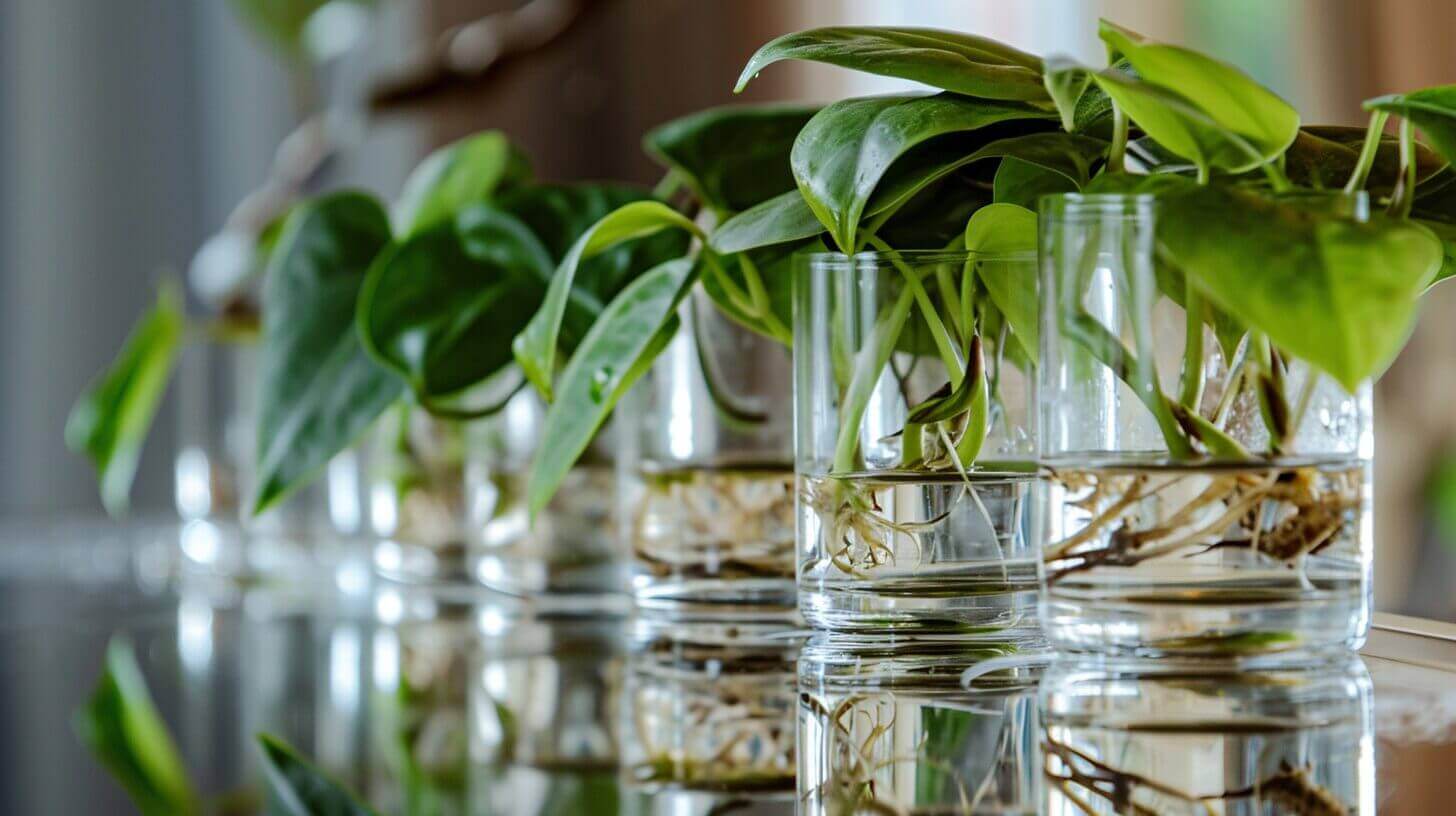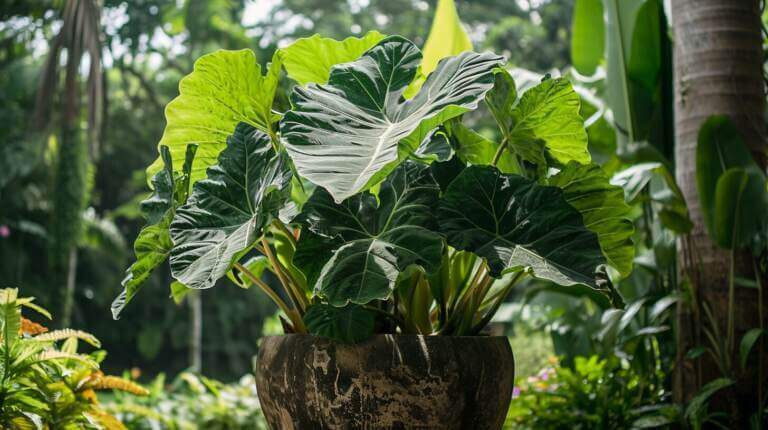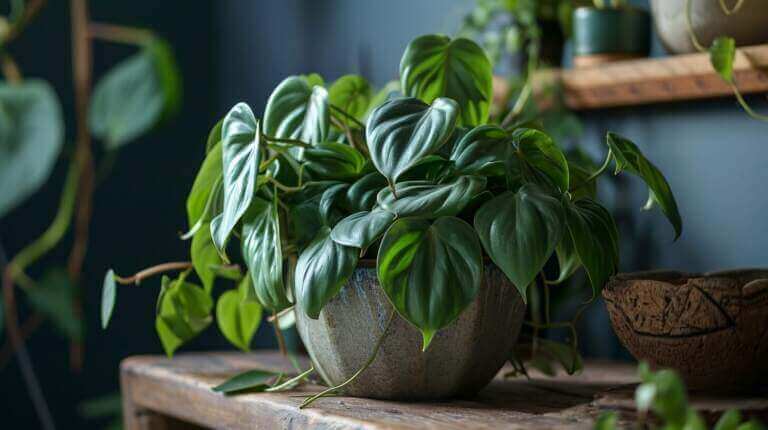How to Propagate Philodendron in Water: A Step-by-Step Guide For Philodendron Propagation
In the lush world of indoor gardening, there exists a magical process known as water propagation. Like a symphony of growth, it allows us to nurture and multiply our beloved philodendron plants with precision and care.
In this step-by-step guide, we will unravel the secrets of this method, guiding you through the art of propagating a philodendron in water.
From selecting the perfect cutting to providing the ideal environment, this informative article will empower you with the knowledge to set your green thumb free.
Key Takeaways
- Select a healthy cutting measuring 6-8 inches in length with a firm stem and several nodes for root development.
- Make a clean cut just below a node when removing the stem from the parent plant.
- Use a clear container with enough depth to hold the cutting securely and submerge the lower nodes in water.
- Regularly monitor water levels, change the water, and provide essential nutrients for root development.
Selecting the Right Stem Cutting For Philodendron Propagation
One key step in propagating a Philodendron in water is selecting the appropriate cutting, ensuring it is healthy and measures around 6-8 inches in length. Choosing the right cutting is essential for successful propagation.
Look for a stem that is firm and free from any signs of disease or damage. A healthy cutting should have several nodes, which are the small bumps where leaves and roots emerge. These nodes will be crucial for root development.
Additionally, select a cutting with at least two to three leaves, as they provide the necessary nutrients for the plant to grow new roots. Remember to use proper cutting techniques when removing the stem from the parent plant. Make a clean cut the stem just below a node and avoid tearing or bruising the stem.
How To Propagate Philodendron in Water
To successfully propagate a Philodendron in water, it is important to properly prepare the water propagation setup and ensure all necessary materials are in place. Choosing the right container is crucial for the success of the propagation process.
Opt for a container that is clear and has enough depth to hold the cutting securely. A glass jar or a vase with a narrow opening works well for this purpose. Make sure the container is clean and free from any residue or contaminants that could harm the cutting.
Monitoring water levels is another essential aspect of preparing the water propagation setup. Fill the container with enough water to submerge the lower nodes of the cutting, but avoid covering the entire stem to prevent rotting. Regularly check the water levels and replenish as needed to maintain the optimal conditions for root growth.
Using a water-soluble fertilizer can also promote healthy root development. By paying attention to these details, you can create an ideal environment for your Philodendron cutting to thrive and grow roots in water.
Taking the Philodendron Cutting
To successfully propagate a Philodendron in water, you will need to carefully select and prepare a healthy cutting from the parent plant. Start by choosing a stem that is at least 6 inches long and has a few nodes or leaves. Using clean, sharp shears, make a clean cut just below a node. This node is where the roots will develop.
If desired, you can use a rooting hormone to encourage root growth. Dip the cut end of the stem into the rooting hormone and shake off any excess. However, it’s important to note that Philodendrons can also be propagated without using rooting hormone.
Once the cutting is prepared, you can proceed to place it in water and wait for roots to develop. Alternatively, you can explore alternative propagation methods such as air layering or planting the cutting directly in potting soil.
Placing the Cutting in Water
After preparing the cutting, carefully submerge it in a container filled with water. Placing the cutting in water is an essential step in propagating a Philodendron. Here are the advantages of water propagation and common mistakes to avoid:
Advantages of water propagation:
- Increased success rate: Water provides the perfect environment for roots to develop, increasing the chances of successful propagation.
- Easy monitoring: Placing the cutting in water allows you to easily monitor its growth and root development.
- Versatility: Water propagation allows you to propagate multiple cuttings at once, making it a versatile method for propagating Philodendrons.
Common mistakes to avoid in water propagation:
- Overcrowding: Avoid placing too many cuttings in a single container, as it can hinder their growth and root development.
- Using unclean water: It is crucial to use clean, distilled water to prevent the growth of harmful bacteria and fungi.
- Neglecting water changes: Regularly change the water to maintain its cleanliness and provide essential nutrients for root development.
Caring for the Propagated Philodendron
The propagated Philodendron’s care requires regular attention and proper maintenance to ensure its health and growth. Once the cutting has developed roots and is transplanted into a pot with soil, it is important to continue providing the necessary care.
One aspect of caring for the propagated Philodendron involves maintaining the water levels. It is crucial to keep the soil consistently moist but not waterlogged. Overwatering can lead to root rot, while underwatering can cause the plant to wilt and suffer. Regularly check the soil moisture level and adjust watering accordingly.
In addition to watering, pruning techniques should be employed to encourage growth and maintain the desired shape of the plant. Prune any dead or damaged leaves, as well as any excessive growth that may hinder the plant’s development.
Frequently Asked Questions
Is Guttation in Philodendron Plants Normal and Does It Affect Propagation in Water?
Yes, guttation in Philodendron plants is normal and it does not affect propagation in water. Sometimes, you may notice water dripping from philodendron leaves. This phenomenon is called guttation and it occurs when excess water is pushed out through the leaf tips. Despite the elimination of excess water, it does not hinder the plant’s ability to propagate in water successfully.
Can Philodendron Propagation Help Fix Drooping Leaves?
Philodendron propagation has proven to be a helpful method in addressing the common causes of drooping philodendron leaves. By carefully propagating healthy stems or cuttings, you can encourage new growth and revive wilted plants. This technique allows for root development and replaces weak or damaged sections, contributing to overall leaf health and regaining the plant’s vitality.
Can the Same Method be Used to Propagate a Heartleaf Philodendron and Other Philodendron Varieties?
Heartleaf philodendron propagation techniques can also be used to propagate other Philodendron varieties. Taking stem cuttings and rooting them in water or moist soil is a common method. Ensure the cutting has one or two leaves and a node, the area where roots will emerge. Maintain high humidity during rooting to enhance success.
Can I Use the Pruning Techniques from the Trimming Guide to Propagate My Philodendron?
Yes, the pruning techniques outlined in the trimming guide can be utilized for propagating your Philodendron plant. By following the easy steps for pruning philodendron, you can not only shape and maintain its growth but also create new plants by rooting the cuttings.
How Long Does It Take for a Philodendron Cutting to Root in Water?
The time it takes for a philodendron cutting to root in water can vary. Factors such as temperature, humidity, and the health of the cutting can influence the rooting process. Generally, it can take around 2-6 weeks for roots to develop.
To ensure successful propagation, it is important to choose a healthy cutting with at least two nodes, provide adequate water and light conditions, and regularly change the water to prevent bacterial growth.
How can I propagate a philodendron in water?
To propagate your philodendron in water, take a stem cutting with at least one node. Place the cutting in a jar of water and change the water every few days.
What is the best way to propagate philodendrons?
The best way to propagate philodendrons is either by stem cutting in water or soil. Both methods are easy to do and can lead to healthy new growth.
Can you grow a philodendron in soil?
Yes, you can grow a philodendron in soil. Use a well-draining soil mix and keep the soil moist but not waterlogged.
How do I care for my philodendron plant?
To keep your philodendron healthy, ensure it gets indirect light, keep the soil moist, and feed it with a balanced houseplant fertilizer.
How do I propagate my philodendron using the soil propagation method?
To propagate your philodendron in soil, take cuttings with at least one node and plant them in potting mix. Keep the soil moist and place the pot in indirect light.
When is the best time to propagate my philodendron?
The best time to propagate your philodendron is during its active growth period, usually in spring or early summer.
Can I grow a new plant from a leaf of my philodendron?
Yes, you can grow a new philodendron plant from a leaf cutting as long as it has a piece of the stem attached.
What should I do if the leaves of my new philodendron are turning yellow?
Yellow leaves on a new philodendron may indicate overwatering. Reduce watering frequency and ensure your pot has good drainage.
How often should I change the water when propagating my philodendron in water?
You should change the water every few days when propagating your philodendron in water to prevent bacterial growth.







